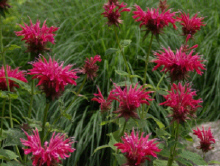Bee Balm, the Versatile Perennial
By Jos Van Hage
Wednesday, September 03, 2008 03:45 AM
 If you are looking for a perennial that will add fragrance as well as color to your landscape you will have to give Beebalm a try. The latin name is Monarda didyma but it has many common names including Bergamot, Oswego Tea, Fragrant Balm, Indian Plume, Mountain Mint, Scarlet Monarda and Beebalm. It is also a herb and native wildflower coming from Eastern North America.
If you are looking for a perennial that will add fragrance as well as color to your landscape you will have to give Beebalm a try. The latin name is Monarda didyma but it has many common names including Bergamot, Oswego Tea, Fragrant Balm, Indian Plume, Mountain Mint, Scarlet Monarda and Beebalm. It is also a herb and native wildflower coming from Eastern North America.
This multi-tasked plant is a member of the mint family and the leaves and flowers have a lemony/orangey mint scent which is very fragrant especially when touched. The oils are sometimes used in the making of perfume and the leaves are a flavouring for Earl Grey tea. Back in the times of the Boston tea party the people of Oswego used the Beebalm leaves to make tea which is where the name Oswego tea comes from. The common name Beebalm comes from the fact that the petals were pounded and made into a poultice to help relieve the sting from bees.
The Beebalm flowers are pretty in bouquets as fresh or dried and the leaves can be dried and used in potpourris as they retain their fragrance well.
Flowers from the beebalm come in red, pink, purple or white and are very showy.
To prolong the blooming season cut the dead flowers out as they appear so that the plant can produce new flowers. For best results plant it in an area where it will receive full sun to light shade. It needs to be planted in a rich, moist, well drained soil but does tolerate heavy clay. The one thing that needs to be watched is powdery mildew which the plant is suspect to. Plant it in an area where there is good air circulation and where it will not be overcrowded. If the plant gets powdery mildew, remove the infected leaves and if the entire plant is infected cut it down to ground level as it will come back up again. Beebalm should be divided every 3-4 years when you notice that the center of the plant is dying out. Divide the plant in spring or fall and toss out the dead center and replant the outside edges in either the same space or in other areas of the garden.
I have beebalm growing in my perennial garden and it blooms for a long time. It attracts the bees, butterflies, and hummingbirds which is an important part in the pollination of the vegetable garden. Another nice thing is that deer will not eat beebalm so it is a good plant to have if you have deer that visit the landscape. Beebalm is a beautiful perennial/herb that will certainly be an asset to any landscape.
-Jos
Jos Van Hage owns and operates two Art Knapp Garden Centres in Prince George
- Highway 16 west at Kimball Road
- Highway 97 North at Northwood Pulpmill road
Previous Story -
Next Story
Posted on Wednesday, September 03, 2008 03:45 AM in
Home and Garden by
Jos Van Hage
 If you are looking for a perennial that will add fragrance as well as color to your landscape you will have to give Beebalm a try. The latin name is Monarda didyma but it has many common names including Bergamot, Oswego Tea, Fragrant Balm, Indian Plume, Mountain Mint, Scarlet Monarda and Beebalm. It is also a herb and native wildflower coming from Eastern North America.
If you are looking for a perennial that will add fragrance as well as color to your landscape you will have to give Beebalm a try. The latin name is Monarda didyma but it has many common names including Bergamot, Oswego Tea, Fragrant Balm, Indian Plume, Mountain Mint, Scarlet Monarda and Beebalm. It is also a herb and native wildflower coming from Eastern North America.








